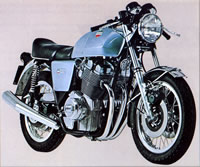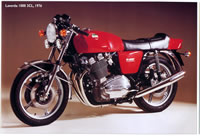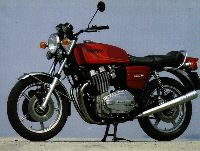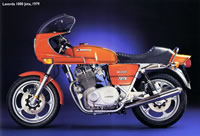TRIPLE - 180 DEGREE
The 3C commenced production late in 1972 with the 2LS Laverda drum brakes front and
rear (eeek!), 35mm Ceriani forks (EEEK!!), a twin cradle frame and lovely big 200mm headlight.
Very quickly the forks were upgraded to somewhat more appropriate 38mm items.  In 1974 model year the triple was upgraded to twin Brembo disc brakes
at the front, and some way through the year saw the appearance of the oil
cooler. The performance of these bikes was pretty awesome by the
standards of the time, however there is no such thing as 'too much horsepower'
and as such, the Slater brothers in England started selling the 3CE (E
for England) in 1975. It was basically a 3C with single seat and
modified exhaust system for improved flow, the collector box was larger
and the pipes had larger outlets and less (or no) baffling. It boosted
the top end power by some 8hp and made it the first production bike to
crack the 140mph mark- exciting stuff! As previously mentioned vibration
was an issue at higher revs and the bike was big and heavy - though no more so than similar bikes of the period - and pretty tall in the saddle. They established a fearsome reputation!
In 1974 model year the triple was upgraded to twin Brembo disc brakes
at the front, and some way through the year saw the appearance of the oil
cooler. The performance of these bikes was pretty awesome by the
standards of the time, however there is no such thing as 'too much horsepower'
and as such, the Slater brothers in England started selling the 3CE (E
for England) in 1975. It was basically a 3C with single seat and
modified exhaust system for improved flow, the collector box was larger
and the pipes had larger outlets and less (or no) baffling. It boosted
the top end power by some 8hp and made it the first production bike to
crack the 140mph mark- exciting stuff! As previously mentioned vibration
was an issue at higher revs and the bike was big and heavy - though no more so than similar bikes of the period - and pretty tall in the saddle. They established a fearsome reputation!
 Nineteen
seventy six marked the first major revision of the triple with the emergence
of the 3CL with it's cast five spoke wheels, side-hinged seat and plastic ducktail.
The new wheels carried two discs at the front and one on the rear, all
280mm Brembos gripped by the same companies twin piston calipers.
This machine formed the basis for the legendary Jota, a machine which
attained cult status in the UK. The original Jotas were once again
built in the UK by Slaters and now featured 4C cams and high compression
pistons, borrowed from the factory endurance racers, lurking within.
These combined with the large-bore collector box and virtually straight-through
'mufflers' (the name hardly seems apt!) to produce performance ahead of anything available at the time.
Much of the mystical reverence toward Laverdas by other motorcyclists
even to this day is based on the reputation this bike developed in the
late 70's. The name Jota comes from a Spanish dance in 3-4 time
and was coined by Roger Slater.
Nineteen
seventy six marked the first major revision of the triple with the emergence
of the 3CL with it's cast five spoke wheels, side-hinged seat and plastic ducktail.
The new wheels carried two discs at the front and one on the rear, all
280mm Brembos gripped by the same companies twin piston calipers.
This machine formed the basis for the legendary Jota, a machine which
attained cult status in the UK. The original Jotas were once again
built in the UK by Slaters and now featured 4C cams and high compression
pistons, borrowed from the factory endurance racers, lurking within.
These combined with the large-bore collector box and virtually straight-through
'mufflers' (the name hardly seems apt!) to produce performance ahead of anything available at the time.
Much of the mystical reverence toward Laverdas by other motorcyclists
even to this day is based on the reputation this bike developed in the
late 70's. The name Jota comes from a Spanish dance in 3-4 time
and was coined by Roger Slater.
These early Jotas were not made in the factory, but were rather 3CL's converted by Slaters with the aforementioned hot up bits. Technically, these were for the UK market only, but a number were exported.
 In 1977 a new larger version of the triple was developed - the 1200. The name was something of a gross exaggeration - the actual capacity being 1116cc - but it sounded good for the marketing! The 1200 was not terribly far removed from the 1000, the main difference being a slightly different upper crankcase and barrel to allow for the capacity, and slightly different tank and sidecovers. For whatever reason, the 1200 did not really catch on, developing (without reason in the author's opinion) a reputation for being somewhat more rough. In reality the 1200 is a gem of an engine, more torquey and when set up correctly just as smooth as the 1000.
In 1977 a new larger version of the triple was developed - the 1200. The name was something of a gross exaggeration - the actual capacity being 1116cc - but it sounded good for the marketing! The 1200 was not terribly far removed from the 1000, the main difference being a slightly different upper crankcase and barrel to allow for the capacity, and slightly different tank and sidecovers. For whatever reason, the 1200 did not really catch on, developing (without reason in the author's opinion) a reputation for being somewhat more rough. In reality the 1200 is a gem of an engine, more torquey and when set up correctly just as smooth as the 1000.
By 1979 the factory assumed production of Jotas, which were now in the classic orange and silver livery and are immediately recognisable by the laid-forward rear shocks and Marzocchi suspension, these were sold alongside the similarly upgraded 3CL. Around this time some ill-considered technical changes were made to crankshaft bearings, head design, and valve springs which caused Laverda no end of grief throughout 1979 and 80. The financial impact of the repairs (when performed) was significant, but the damage to the reputation was also a major blow. The 1980 Jota gained a frame mounted fairing - not the greatest styling success of all time - but few other changes.
 1981
saw the first significant re-engineering of the engine with the emergence of the 'Mark II' 180. The ignition pickups were moved to the left hand side
of the crankshaft and a Nippondenso alternator was fitted to the right.
Not only did this change even up the lumpy early motor with its large alternator on the right side, it also
addressed the poor charging rate of the early
Bosch alternators. Changes were made to the crankcase and primary cover
in readiness for a left-foot gear change but for the moment the familiar
right-side mechanism remained, although operated now via a hydraulic clutch
which somewhat improved the heavy clutch pull. The fairing was new and in my opinion
a huge improvement over the 1980 version, though some dislike it. This represented the
end of the line for the 180 motors, they were no longer at the forefront
of performance but remained highly respected and capable road-burners.
1981
saw the first significant re-engineering of the engine with the emergence of the 'Mark II' 180. The ignition pickups were moved to the left hand side
of the crankshaft and a Nippondenso alternator was fitted to the right.
Not only did this change even up the lumpy early motor with its large alternator on the right side, it also
addressed the poor charging rate of the early
Bosch alternators. Changes were made to the crankcase and primary cover
in readiness for a left-foot gear change but for the moment the familiar
right-side mechanism remained, although operated now via a hydraulic clutch
which somewhat improved the heavy clutch pull. The fairing was new and in my opinion
a huge improvement over the 1980 version, though some dislike it. This represented the
end of the line for the 180 motors, they were no longer at the forefront
of performance but remained highly respected and capable road-burners.

